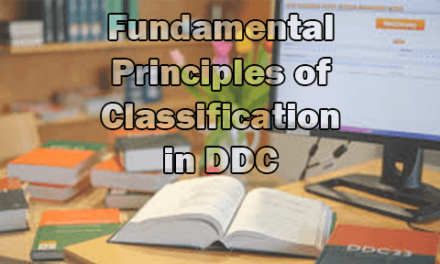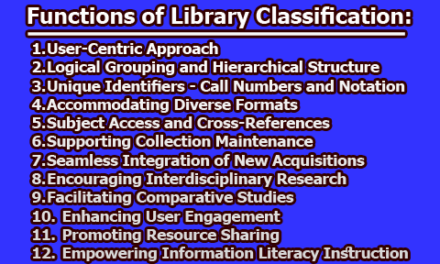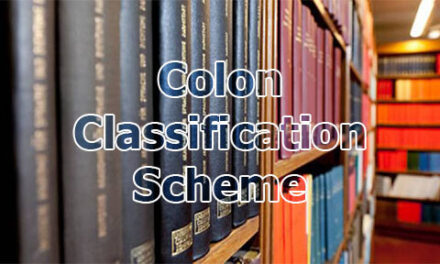Library of Congress Classification:
The Library of Congress Classification (LCC) is a classification system used by the Library of Congress and other libraries around the world to organize and arrange books and other materials on shelves. It was developed by the Library of Congress in the early 20th century and is widely used in academic and research libraries in the United States, as well as in many other countries. The LCC is a flexible and adaptable system, allowing libraries to modify it to fit their specific collections and needs. It is also constantly evolving, with new sub-classes and revisions to existing classes being added as new areas of knowledge emerge.
Basic Structure of LCC:
- Developed independently by different groups of subject specialists.
- Enumerate aspects of a subject explicitly provided by the schedules.
- The entire field of knowledge is divided into main classes.
- Denoted by single capital letters.
- To serve Congress with its need for a collection in history and the social sciences, these disciplines received multiple classes and subclasses for examples;
History – C, D, E, F, G
Social Sciences – H, J, K, L
- Broad Outline of LCC:
i. General Works (A)
ii. Humanistic Disciplines & Social Sciences (B-P)
Examples; Philosophy, Religion, History, Geography, Anthropology, Social Sciences, Music, Fine Arts, Language and Literature.
iii. Natural Sciences & Technology (Q-V)
Examples; Math, Physics & Biological Sciences, Medicine and Agriculture, Technology, Military, and Naval Sciences
iv. Bibliography & Library Science (Z)
- LCC includes the 21 main classes as follows:
A – General Works
B – Philosophy, Psychology, and Religion
C – Auxiliary Sciences of History
D – World History and History of Europe, Asia, Africa, Australia, New Zealand, etc.
E – History of the Americas
F – Local History of the United States and British, Dutch, French, and Latin America
G – Geography, Anthropology, and Recreation
H – Social Sciences
J – Political Science
K – Law
L – Education
M – Music
N – Fine Arts
P – Language and Literature
Q – Science
R – Medicine
S – Agriculture
T – Technology
U – Military Science
V – Naval Science
Z – Bibliography, Library Science, and General Information Resources
- Main Classes are further divided into subclasses: which represent branches of the disciplines, most subclasses are denoted by double capital letters, for examples;
Class A General Works:
AC – Collections, Series, Collected Works
AE – Encyclopedias
AG – Dictionaries and Other General Reference Works
AI – Indexes
AM – Museums, Collectors, and Collecting
AN – Newspapers
AP – Periodicals
AS – Academies and Learned Societies
AY – Yearbooks, Almanacs, Directories
AZ – History of Scholarship and Learning the Humanities
Class N Fine Arts:
NA – Architecture
NB – Sculpture
NC – Drawing. Design. Illustration
ND – Painting
NE – Print Media
NK – Decorative Arts
NX – Arts in General
- Schedules D and K use triple letters:
DAW – History of Central Europe
KBP – Islamic Law
- Schedules E and F use single letters:
E – History of the Americas
F – Local History of the United States and British, Dutch, French, and Latin America
- Class Z formerly used the single letter Z. Now we also have subclass ZA – Information Resources.
- Subclasses are further divided to specify form, place, time & subtopics.
- “See” notes are used to indicate topics relocated to other parts of the schedules.
- “Including” notes provide examples of the topics covered by a particular caption.
Special Features of LCC:
There are several special features of the Library of Congress Classification (LCC) system that make it a valuable tool for organizing and accessing information:
- Hierarchical structure: The LCC system is hierarchical, meaning that each item is assigned to the most specific sub-class that applies to it. This allows materials on similar topics to be grouped together on library shelves, making it easier for users to find and access the materials they need.
- Consistency: The LCC system is consistently applied across all libraries that use it, which makes it easier for library users to navigate and understand the organization of different libraries.
- Flexibility: The LCC system is flexible and can be adapted to different types of libraries and collections. Libraries can add their own unique subclasses or modify existing ones to better suit their needs.
- Faceted approach: The LCC system uses a faceted approach to classification, meaning that it considers different facets of a subject or work. For example, a book on the history of photography might be classified under both “TR” (Photography) and “D” (World History and History of Europe, Asia, Africa, Australia, New Zealand, etc.) to reflect the different facets of the work.
- Comprehensive coverage: The LCC system covers a wide range of subjects, making it suitable for libraries with diverse collections. It includes classes for everything from General Works (Class A) to Naval Science (Class V) to Religion (Class BL) to Medicine (Class R).
- Alphabetical and Numerical Notation: The LCC system uses a combination of alphabetical and numerical notation to classify items. The alphabetical notation is used for subclasses (e.g., “PN” for Literature – General and Comparative), while the numerical notation is used for specific items within subclasses (e.g., “1993” for a particular book on literary criticism).
- Standardization: The LCC system is standardized across libraries, meaning that a book on a particular subject will have the same classification number in all libraries that use the system. This makes it easier for library users to find materials on a specific subject across different libraries.
- Online Accessibility: The LCC system is available online, making it easy for librarians and library users to access information about specific classifications and subclasses from anywhere with an internet connection.
- Comprehensive Subject Coverage: The LCC system is designed to cover a wide range of subjects, from the sciences to the humanities to the arts. This makes it a useful tool for libraries with diverse collections.
- Special Subclasses: The LCC system includes special subclasses for materials that require unique classifications, such as maps (subclass “G”), music (subclass “M”), and law (subclass “K”).
It is apparent that the LCC system is a widely-used tool for organizing and accessing information in libraries. The LCC system uses a hierarchical structure, alphabetical and numerical notation, and a faceted approach to classification, allowing materials on similar topics to be grouped together on library shelves. The system is standardized across libraries, flexible, and can be adapted to suit the needs of different types of libraries and collections. The LCC system covers a wide range of subjects, making it suitable for libraries with diverse collections, and includes special subclasses for materials that require unique classifications. The LCC system’s comprehensive subject coverage, flexibility, and standardization make it an effective and valuable tool for librarians and library users alike.

Library Lecturer at Nurul Amin Degree College










